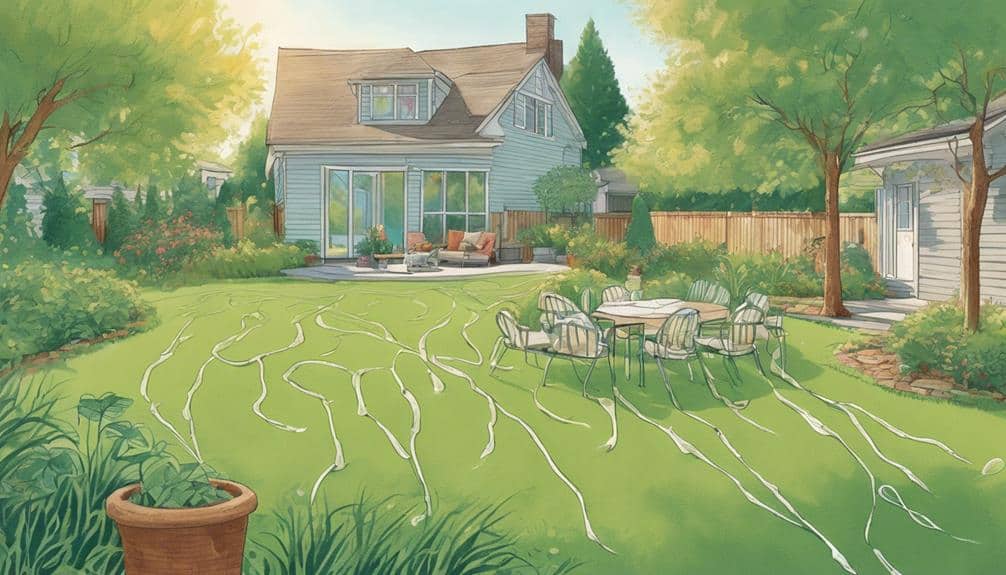You're likely dealing with a flea infestation in your yard, and it's essential to act fast. To get rid of fleas, you'll need to identify their hiding spots, focusing on warm, shady, and moist areas. Treat your yard with insecticides, wearing protective gear and following instructions carefully. You can also use nematodes, natural predators of flea larvae, to create a long-term solution. Create flea-repellent barriers with herbs, cedar chips, or diatomaceous earth. If the problem persists, consider calling in a professional pest control service. To explore these methods further and find the best solution for your yard, take the next step.
Key Takeaways
• Identify flea hiding spots in warm, shady, and moist areas, such as pet bedding and outdoor lounging spots, to target treatment effectively.
• Treat the yard with environmentally-friendly insecticides, wearing protective gear and following instructions carefully to ensure safe treatment.
• Introduce nematodes, natural predators of flea larvae, into the yard to create a long-term solution for controlling fleas.
• Create flea-repellent barriers by planting herbs like lavender, using cedar chips, and installing physical barriers like fences or gravel strips.
• Call in professional pest control services for severe cases, guaranteeing a thorough treatment that targets flea infestations efficiently.
Identify Flea Hiding Spots
When searching for flea hiding spots in your yard, focus on warm, shady, and moist areas where your pets tend to congregate. These areas are important breeding grounds for fleas, and your pets' fur can easily pick up these pesky parasites.
Check areas around pet bedding, garden furniture, and other outdoor spots where your pets like to lounge. Fleas often hide in hard-to-reach areas, so be thorough in your inspection. Consider wearing white socks to easily spot fleas in the yard – the contrast will make them more visible.
Don't forget to inspect potential areas around trees, fences, and doghouses, as these can be prime flea hiding spots. As an outdoor pet owner, it's crucial to regularly inspect your yard for signs of fleas.
Treat Yard With Insecticides

To effectively eliminate fleas from your yard, you'll need to treat the area with insecticides specifically designed for outdoor flea treatment. When using insecticides, it's crucial to wear protective gear and follow the instructions carefully to guarantee safe and effective treatment. Opt for environmentally-friendly options to minimize the impact on your yard's ecosystem.
Spraying insecticides in shaded, moist areas where fleas thrive can help eradicate adult fleas and disrupt their life cycle. Regularly treating your yard with insecticides will prevent re-infestation and guarantee long-term flea control outdoors.
You can choose to apply the insecticides yourself or hire a professional pest control service to efficiently eliminate fleas in your yard.
Use Nematodes for Flea Control

You can complement your outdoor flea treatment by introducing beneficial nematodes into your yard, which act as natural predators that feed on flea larvae. These microscopic roundworms are a safe and effective way to control flea infestations in your yard.
Here are some benefits of using nematodes for flea control:
- Natural predators: Nematodes feed on flea larvae, reducing the flea population in your yard.
- Safe for pets: Nematodes are harmless to pets, plants, and beneficial insects, making them an ideal solution for flea control.
- Decrease flea infestations: Regular use of nematodes can decrease flea infestations over time, helping to maintain a healthy balance in your yard.
- Long-term solution: By introducing nematodes into your yard, you can create a long-term solution for controlling fleas, reducing the need for chemical treatments.
Create Flea-Repellent Barriers

Set up flea-repellent barriers around your yard by incorporating specific plants, materials, and structures that can help deter these pests from entering your outdoor space. One effective way is to plant flea-repellent herbs like lavender, mint, and rosemary around the yard perimeter. These natural herbs can create a barrier against fleas, preventing them from entering your yard.
| Barrier Type | Description | Effectiveness |
|---|---|---|
| Herbal Barrier | Planting flea-repellent herbs like lavender, mint, and rosemary | High |
| Cedar Barrier | Using cedar chips or cedar oil strategically in the yard | High |
| Physical Barrier | Installing a fence or gravel strip to prevent wildlife entry | Medium |
| Diatomaceous Earth Barrier | Utilizing diatomaceous earth along yard boundaries | Medium |
| Living Barrier | Using nematodes to create a living barrier in the soil | High |
Call in Professional Pest Control

When your yard is overrun with fleas, calling in a professional pest control service can be the most effective way to quickly and thoroughly eliminate the infestation. These experts offer efficient solutions for severe cases, providing quick relief from the infestation.
Here are some benefits of hiring a professional pest control service:
- Expertise: Pest control professionals have the expertise to tackle flea problems effectively, guaranteeing a thorough treatment.
- Efficient Solutions: They provide efficient solutions for severe cases, saving you time and ensuring a quick eradication of fleas.
- Thorough Treatment: Professionals guarantee a thorough treatment, targeting flea infestations directly and providing quick relief.
- Quick Relief: By contacting professionals for yard flea treatment, you can get quick relief from the infestation, restoring your yard to a comfortable and safe space.
While it may cost more, professional help saves time and guarantees a thorough treatment. Don't hesitate to call in a professional pest control service to tackle your flea problem and enjoy your yard again.
Frequently Asked Questions
What Is the Fastest Way to Get Rid of Fleas in the Yard?
You're wondering what's the fastest way to get rid of fleas in your yard?
Well, you can't go wrong with flooding the area with water to drown those pesky larvae and eggs quickly.
Alternatively, using insecticides specifically designed for outdoor flea control will give you rapid results.
If you want a thorough solution, consider hiring professional pest control services.
What Is the Best Homemade Flea Killer for Your Yard?
Think of your yard as a battlefield, and fleas are the enemy – you need the right ammunition to win the war.
When it comes to homemade flea killers, you have several options. A mixture of dish soap and water is a potent spray that kills fleas on contact.
Alternatively, a citrus-based solution using lemon juice can repel them.
You can also try a vinegar-based solution or diatomaceous earth for a more natural approach.
Choose your weapon wisely to conquer the flea infestation in your yard.
How Do I Get Rid of Thousands of Fleas?
You're overwhelmed with a massive flea infestation! First, treat your pets to prevent reinfestation.
Then, consider flooding your yard to drown larvae and eggs.
Next, use insecticides labeled for outdoor use or try natural methods like cedar chips or nematodes.
If the problem persists, don't hesitate to seek professional help.
What Do You Spray on Grass to Kill Fleas?
When it comes to spraying your grass to kill fleas, you'll want to use insecticides specifically designed for outdoor use. Look for environmentally friendly options to avoid harming beneficial insects and wildlife.
You can also consider natural alternatives like cedar chips, which repel fleas and create a barrier against infestations. Whatever you choose, make sure to follow the product's instructions diligently to guarantee effective flea control.



